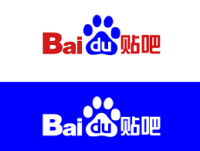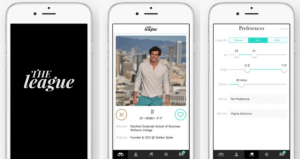Difference between revisions of "The League (Dating App)"
| Line 2: | Line 2: | ||
{{SoftwareInfoBox | {{SoftwareInfoBox | ||
|NAME=''The League'' | |NAME=''The League'' | ||
| − | |HEIGHT= | + | |HEIGHT=430 |
|LOGO=logo.png | |LOGO=logo.png | ||
| + | |CAPTION =Interface of the Application | ||
|SCREENIMAGE=league.png | |SCREENIMAGE=league.png | ||
|TYPE =Dating Application | |TYPE =Dating Application | ||
| − | | | + | |developer=Amanda Bradford |
| − | + | ||
|LAUNCH =January 17, 2015 | |LAUNCH =January 17, 2015 | ||
|PLATFORM =iOS, Android | |PLATFORM =iOS, Android | ||
| Line 13: | Line 13: | ||
}} | }} | ||
| − | [https://www.theleague.com The League] is | + | [https://www.theleague.com The League] is a mobile dating application that was launched in 2015 by developer Amanda Bradford. As a members-only application, users must submit a request to be admitted to the dating app. With the intention of attracting only “professionals” to the app, your acceptance and match is solely based on your LinkedIn and Facebook profiles. Users may be subject a long waitlist before admittance onto the app. |
| + | |||
==History== | ==History== | ||
| − | + | The dating application was founded in 2014 by Amanda Bradford, who thought of the idea after being frustrated by her own online dating experience. Bradford states that one of her models is the Soho House, the members-only social club that opened in London and then went to different cities. Similarly, The League first started in San Fransico in 2015 and has now debuted in 21 cities across the nation. | |
| − | |||
==Process== | ==Process== | ||
| − | + | A user can either apply to the dating app through a referral or without a referral. With a referral from a friend, a user is able to skip the application process. Otherwise, a user can sign up for the app and then be placed on a waitlist. The application then scan’s an applicant’s Facebook and LinkedIn profiles to analyze their “personality.” Education, profession, and age are some of the important factors included in the selection process. | |
| + | |||
| + | Once admitted off the waitlist, a user can sync their Facebook and LinkedIn accounts to create their profile. They are then prompted to select their preferences for matches, which include gender, location proximity, height, education level, religion and ethnicity. Similar to other dating application, a user is given matches and then prompted to swipe right to “match” or swipe left to “pass.” Unlike other apps, the League only gives you 3-5 matches per day, depending on which subscription you have. | ||
| − | |||
| − | |||
==Controversy== | ==Controversy== | ||
| − | + | There have been many press accusations of the dating app being racist due to its selection process. Because the app requires the user to submit his or her race, many have criticized the app for being one of the only dating applications that does this. Developer and CEO Amanda Bradford claims that the [http://www.complex.com/pop-culture/2015/01/the-league-dating-app-racist.html ethnicity data] is important to help the site be more inclusive by welcoming all diversities. | |
| + | |||
| + | In addition, the app’s selective process of being only for “elite” members has also been of concern to many. While The League determines your acceptance based on your LinkedIn and Facebook profiles, some consider the app to be “unethical” in the way it determines who gets let in, as it could be true that members will higher levels of education and profession are accepted. | ||
| + | |||
| − | == | + | ==Monochrome Profiles== |
| − | + | In October 2017, The League launched its “monochrome” profile, making each user’s first profile picture black and white. The reason for doing so has been said to urge users to make more “holistic” decisions when making a match. While it might be easier for people to make judgments based on the appearance of their picture, it may be harder to do so when the photo appears in black and white. | |
| − | + | When [https://techcrunch.com/2017/10/24/the-league-is-making-everyones-first-profile-picture-black-and-white/.html A/B tests] were conducted before the change, users spent twice as long looking at a match’s profile when the picture appeared in monochrome. Therefore, the application hopes that making this change will urge users to spend more time looking at someone’s interests and profession as opposed to just their picture. | |
Revision as of 01:10, 20 March 2018
|
The League is a mobile dating application that was launched in 2015 by developer Amanda Bradford. As a members-only application, users must submit a request to be admitted to the dating app. With the intention of attracting only “professionals” to the app, your acceptance and match is solely based on your LinkedIn and Facebook profiles. Users may be subject a long waitlist before admittance onto the app.
History
The dating application was founded in 2014 by Amanda Bradford, who thought of the idea after being frustrated by her own online dating experience. Bradford states that one of her models is the Soho House, the members-only social club that opened in London and then went to different cities. Similarly, The League first started in San Fransico in 2015 and has now debuted in 21 cities across the nation.
Process
A user can either apply to the dating app through a referral or without a referral. With a referral from a friend, a user is able to skip the application process. Otherwise, a user can sign up for the app and then be placed on a waitlist. The application then scan’s an applicant’s Facebook and LinkedIn profiles to analyze their “personality.” Education, profession, and age are some of the important factors included in the selection process.
Once admitted off the waitlist, a user can sync their Facebook and LinkedIn accounts to create their profile. They are then prompted to select their preferences for matches, which include gender, location proximity, height, education level, religion and ethnicity. Similar to other dating application, a user is given matches and then prompted to swipe right to “match” or swipe left to “pass.” Unlike other apps, the League only gives you 3-5 matches per day, depending on which subscription you have.
Controversy
There have been many press accusations of the dating app being racist due to its selection process. Because the app requires the user to submit his or her race, many have criticized the app for being one of the only dating applications that does this. Developer and CEO Amanda Bradford claims that the ethnicity data is important to help the site be more inclusive by welcoming all diversities.
In addition, the app’s selective process of being only for “elite” members has also been of concern to many. While The League determines your acceptance based on your LinkedIn and Facebook profiles, some consider the app to be “unethical” in the way it determines who gets let in, as it could be true that members will higher levels of education and profession are accepted.
Monochrome Profiles
In October 2017, The League launched its “monochrome” profile, making each user’s first profile picture black and white. The reason for doing so has been said to urge users to make more “holistic” decisions when making a match. While it might be easier for people to make judgments based on the appearance of their picture, it may be harder to do so when the photo appears in black and white.
When A/B tests were conducted before the change, users spent twice as long looking at a match’s profile when the picture appeared in monochrome. Therefore, the application hopes that making this change will urge users to spend more time looking at someone’s interests and profession as opposed to just their picture.

